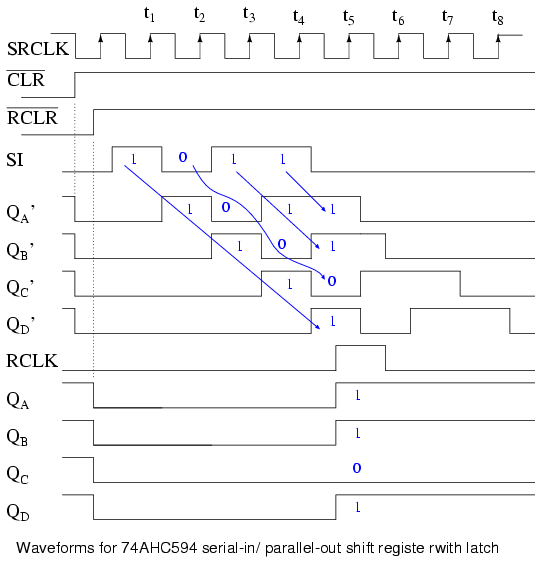Serial Input Paralel Output Sipo
This sequential device loads the data present on its inputs and then moves or “shifts” it to its output once every clock cycle, hence the name “ shift register”. A shift register basically consists of several single bit “D-Type Data Latches”, one for each data bit, connected together in a serial type daisy-chain arrangement so that the output from one data latch becomes the input of the next latch and so on. Data bits may be fed in or out of a shift register serially, that is one after the other from either the left or the right direction, or all together at the same time in a parallel configuration.
The output from one flip-flop becomes the input of the next flip-flop. Serial In - Serial Out, Serial In - Parallel Out, Parallel In – Serial Out.
The number of individual data latches required to make up a single Shift Register device is usually determined by the number of bits to be stored. Shift Registers are commonly used inside calculators or computers to store data such as two binary numbers before they are added together, or to convert the data from either a serial to parallel or parallel to serial format. The individual data latches that make up a single shift register are all driven by a common clock ( Clk ) signal making them synchronous devices. Shift register IC’s are generally provided with a clear or reset connection so that they can be “SET” or “RESET” as required. Generally, shift registers operate in one of four different modes with the basic movement of data through a shift register such as: • Serial-in to Serial-out (SISO): The register is loaded with serial data,one bit at a time, and shifted serially out of the register, one bit at a time in either a left or right direction under clock control. • Serial-in to Parallel-out (SIPO): The register is loaded with serial data, one bit at a time, with the stored data being available at the output in parallel form.
• Parallel-in to Serial-out (PISO): The parallel data is loaded into the register simultaneously and is shifted out of the register serially one bit at a time under clock control. • Parallel-in to Parallel-out (PIPO): The parallel data is loaded simultaneously into the register, and transferred together to their respective outputs by the same clock pulse.
The effect of data movement from left to right through a shift register can be presented graphically as: Fig.1 Serial-in to Serial-out (SISO) Shift Register Let all the flip-flop be initially in the reset condition i.e. Q A = Q B = Q C = Q D = 0. We enter a four bit binary number 1 1 1 1 into the register. This number should be applied to D in bit, with the LSB bit applied first. The D input of FFA i.e. D A is connected to serial data input D in.
Output of FFA i.e. Q A is connected to the input of the next flip-flop i.e. D B and so on. Block Diagram Fig.2 Operation Before the application of clock signal let all the flip-flop be initially in the reset condition i.e. Q A = Q B = Q C = Q D = 0 and apply the LSB bit of the number to be entered to D in.
So D in=D A=1. Now apply the clock.

On the first falling edge of clock, the FFA is set, and stored word in the register is, Q A Q B Q C Q D = 1000. Fig.3 Apply the next bit to D in.
As soon as the next negative edge of the clock hits, FF-B will set and the stored word change to Q A Q B Q C Q D = 1100. Fig.4 Apply the next bit to be stored i.e. Apply the clock pulse. As soon as the third negative clock edge hits, FF-C will be set and output will be modified to Q A Q B Q C Q D = 1110.
Fig.5 Similarly with D in=1 and with the fourth negative clock edge arriving, the stored word in the register is Q A Q B Q C Q D = 1111. Truth Table Wave Forms Fig.7 Serial-in to Parallel-out Shift Register (SIPO) • In such types of operations, the data is entered serially and taken out in parallel fashion. Pesni iz svatov youtube.